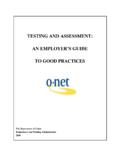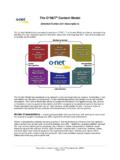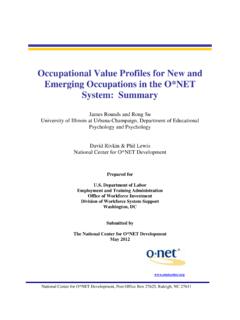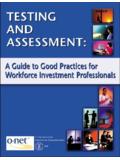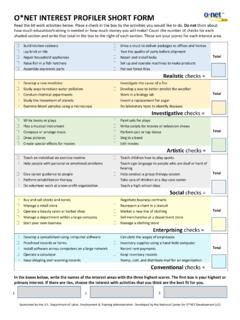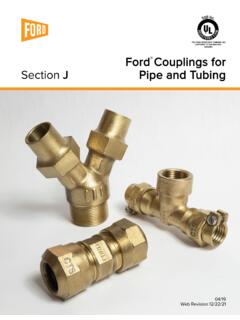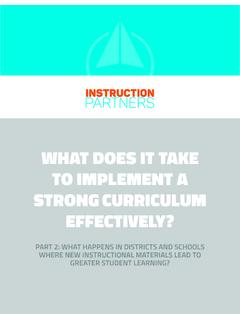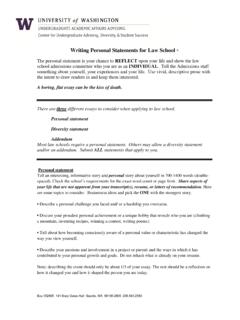Transcription of Item1 WIL Instrument Final
1 Version TM. work importance locator Instrument a tool for career exploration Department of Labor Employment and Training Administration TM. T H E O * N E T C A R E E R E X P LO R AT I O N T O O L S. As you explore your career options, you should know that other tools are available to help you. The Work Importance Locator is just one of five O*NET Career Exploration Tools. The other tools are: The Work Importance Profiler a computer-based version of the Work Importance Locator, it helps you decide what is important to you in a job. It can help you identify occupations that you may find satisfying. The Computerized Interest Profiler helps you find out what your work-related interests are. The Interest Profiler (paper version) is similar to the Computerized Interest Profiler, except that you answer and score the questions by hand. The Ability Profiler helps you find out what kinds of jobs you can learn to do well.
2 It can help you recognize where your strengths are and areas where you might need more training or education. These tools give you three important pieces of information that are valuable to you when exploring careers: (1) what is important to you in your world of work, (2) what you can do well, and (3) what you like to do. You may use the tools separately or together. You can use them to identify occupations in the world of work that you may want to explore. 2000, Department of Labor, Employment and Training Administration. All rights reserved. G E T T I N G S TA R T E D. First, write your name and the date. Then, continue by reading the section below, titled Welcome to the Work Importance Locator.. N A M E : _____ D AT E : _____. WELCOME TO THE WORK IMPORTANCE LOCATOR. The Work Importance Locator can help you learn more about your work values and can help you decide what is important to you in a job.
3 It does this by asking you to rank different aspects of work that represent six important work values. Knowing your work values can help you decide what kinds of jobs and careers you might want to explore. When you complete the Locator, you will get scores for six work values. These scores show how important each of the work values is to you. In addition to your scores, you will be directed to a list of occupations that are linked with your work values. This list can help you explore career options. The more a job agrees with your work values, the more likely you are to be satisfied in that job. You should use your Work Importance Locator results for career exploration and career counseling purposes. Talk to a vocational/. employment counselor or teacher for more help on how to use the tool. Your Work Importance Locator results should not be used for employment or hiring decisions.
4 Employers, education programs, or other job-related programs should not use your results as part of a screening process for jobs or training. If you think that your Work Importance Locator results are being used incorrectly, talk to your vocational/employment counselor, teacher, or program administrator. You can also contact the National Center for O*NET Development for assistance. National Center for O*NET Development Phone: (919) 733-2790. Attention: Customer Service Fax: (919) 715-0778. 700 Wade Avenue e-mail: Raleigh, NC, 27605. B E F O R E YO U B E G I N. There are no right or wrong answers in this survey. Different people may feel differently about the statements. You are just being asked how you feel. Please answer honestly and carefully. You should have the following materials in your Work Importance Locator package: 20 Work Value cards, a Work Value Card Sorting Sheet, a Work Importance Locator Score Report, containing lists of occupations, and these instructions.
5 Turn the page PA G E 1. INSTRUCTIONS. The Work Importance Locator is different from other surveys you may have taken in the past. Instead of questions, the Work Importance Locator uses cards with statements about different aspects of work. You are to sort the cards into groups based on how important the statement on each card is to you on your ideal job the kind of job you would most like to have. Please complete and score the survey yourself by following the steps in order. These steps are presented on the next several pages. Do all the steps in order. STEP 1. READ THE C ARDS. Find the 20 Work Value Cards in the packet provided to you. Read all 20 cards before you go to Step 2. Think about how important it would be for you to have a job like the one described on each card. STEP 2. SORT THE C ARDS. Find the Work Value Card Sorting Sheet in the packet provided to you.
6 Notice the five columns printed under the Importance Scale at the top of the sheet. Each column has a number from 5 (Most Important) to 1 (Least Important). Put each card in the column that best matches how important it is for you to have a job like the one described on the card. Put exactly 4 cards in each column. When you are done, the four most important statements should be in Column 5, the four next most important should be in Column 4, and so on. The four least important statements should be in Column 1. You may have to move the cards around until you have exactly 4 cards in each column. Look at the example on the next page for help. PA G E 2. H O W T O C O M P L E T E T H E W O R K I M P O R TA N C E L O C AT O R. FOR EXAMPLE: If CARD A describes something that is more important to you than what is on the other cards, put CARD A in COLUMN 5.
7 WORK VALUE CARD SORTING SHEET. I M P O R TA N C E S C A L E. MOST IMPORTANT LEAST IMPORTANT. COLUMN COLUMN COLUMN COLUMN COLUMN. STEP 2. SORT THE CARDS. 5 4 3 2 1. Notice the five columns printed under the Importance Scale at the A. top of the sheet. Each On my ideal job it is important (PLACE ONE HERE.) (PLACE ONE CARD HERE.) (PLACE ONE CARD HERE.) (PLACE ONE CARD HERE.) (PLACE ONE CARD HERE.). column has a number from 5 (Most ..I make use of my abilities. Important) to 1 (Least Important). Put each card in the column that best matches how important it is for you to have a job like the one described on the card. (PLACE ONE CARD HERE.) (PLACE ONE CARD HERE.) (PLACE ONE CARD HERE.) (PLACE ONE CARD HERE.) (PLACE ONE CARD HERE.). Put exactly 4 cards in each column. When you are done, the four most important statements should be in Column 5, the four next most important (PLACE ONE CARD HERE.)
8 (PLACE ONE CARD HERE.) (PLACE ONE CARD HERE.) (PLACE ONE CARD HERE.) (PLACE ONE CARD HERE.). statements should be in Column 4, and so on. The four least important state- ments should be in Column 1. You may have to move the cards around until you have exactly 4. cards in each column. After you have sorted all (PLACE ONE CARD HERE.) (PLACE ONE CARD HERE.) (PLACE ONE CARD HERE.) (PLACE ONE CARD HERE.) (PLACE ONE CARD HERE.). of the cards, go to Step 3. on page 4 of your booklet and figure out your scores. On the other hand, if CARD A is less important to you when compared with the other cards, put CARD A in COLUMN 1. If CARD A is neither the most important nor the least important, put it in one of the other columns (4, 3, or 2) that best matches how you feel. Do the same thing for all of the cards. WORK VALUE CARD SORTING SHEET. I M P O R TA N C E S C A L E.
9 MOST IMPORTANT LEAST IMPORTANT. COLUMN COLUMN COLUMN COLUMN COLUMN. STEP 2. SORT THE CARDS. 5 4 3 2 1. Notice the five columns printed under the Importance Scale at the A. top of the sheet. Each On my ideal job it (PLACE ONE CARD HERE.) (PLACE ONE CARD HERE.) (PLACE ONE CARD HERE.) is important (PLACE ONE HERE.). column has a number (PLACE ONE CARD HERE.). from 5 (Most ..I make use of my abilities. Important) to 1 (Least Important). Put each card in the column that best matches how important it is for you to have a job like the one described on the card. (PLACE ONE CARD HERE.) (PLACE ONE CARD HERE.) (PLACE ONE CARD HERE.) (PLACE ONE CARD HERE.) (PLACE ONE CARD HERE.). Put exactly 4 cards in each column. When you are done, the four most important statements should be in Column 5, the four next most important (PLACE ONE CARD HERE.) (PLACE ONE CARD HERE.)
10 (PLACE ONE CARD HERE.) (PLACE ONE CARD HERE.) (PLACE ONE CARD HERE.). statements should be in Column 4, and so on. The four least important state- ments should be in Column 1. You may have to move the cards around until you have exactly 4. cards in each column. After you have sorted all (PLACE ONE CARD HERE.) (PLACE ONE CARD HERE.) (PLACE ONE CARD HERE.) (PLACE ONE CARD HERE.) (PLACE ONE CARD HERE.). of the cards, go to Step 3. on page 4 of your booklet and figure out your scores. Turn the page and go to Step 3. PA G E 3. HOW TO SCORE YOUR WORKSHEET. S T E P 3 . F I G U R E O U T YO U R W O R K VA LU E S C O R E S. The six Work Values are: ACHIEVEMENT. INDEPENDENCE. RECOGNITION. R E L AT I O N S H I P S. SUPPORT. WORKING CONDITIONS. They are presented to you in boxes on the opposite page. Using the Worksheet on the opposite page, figure out your scores for these six work values as follows: Look at your Card Sorting Sheet.
